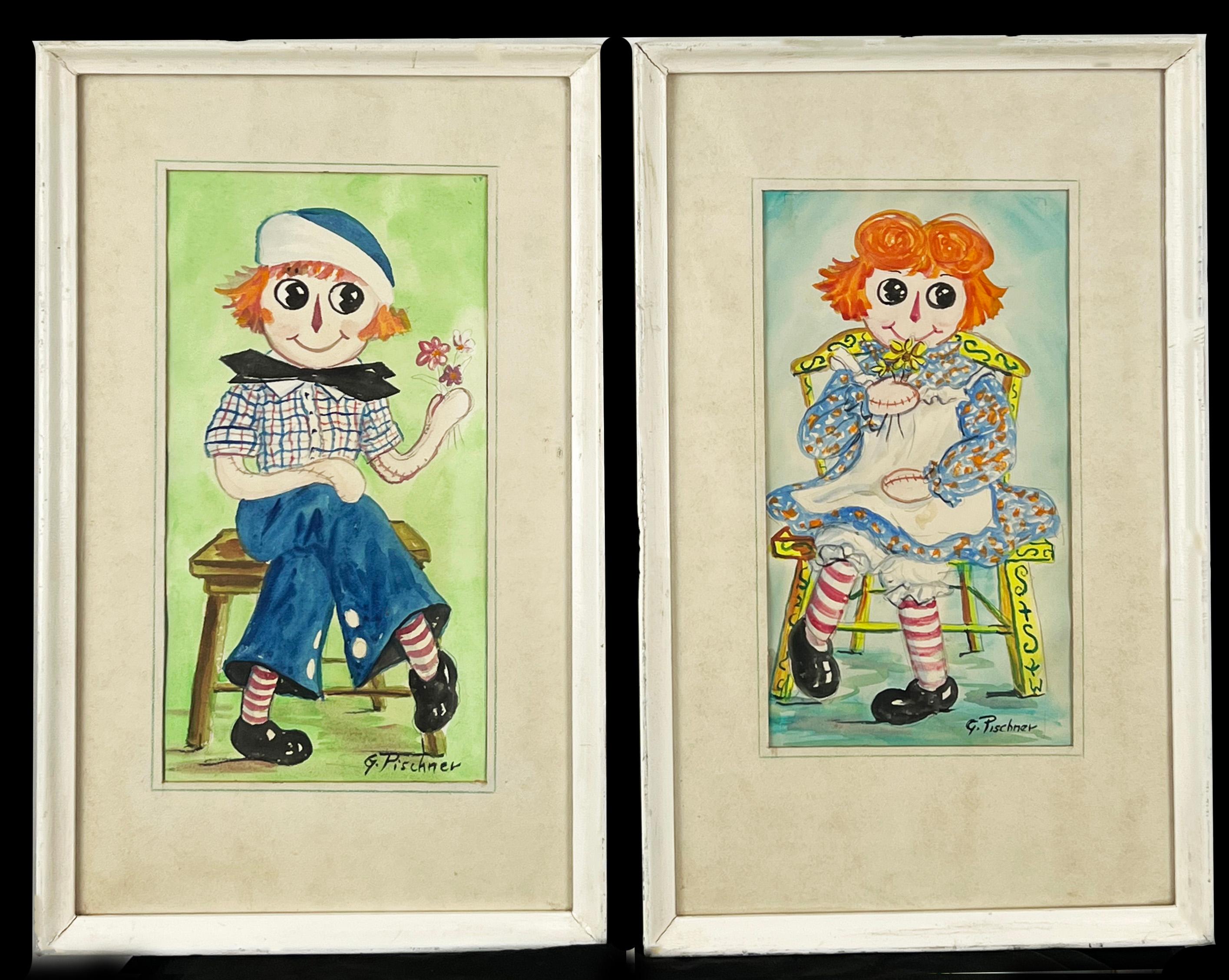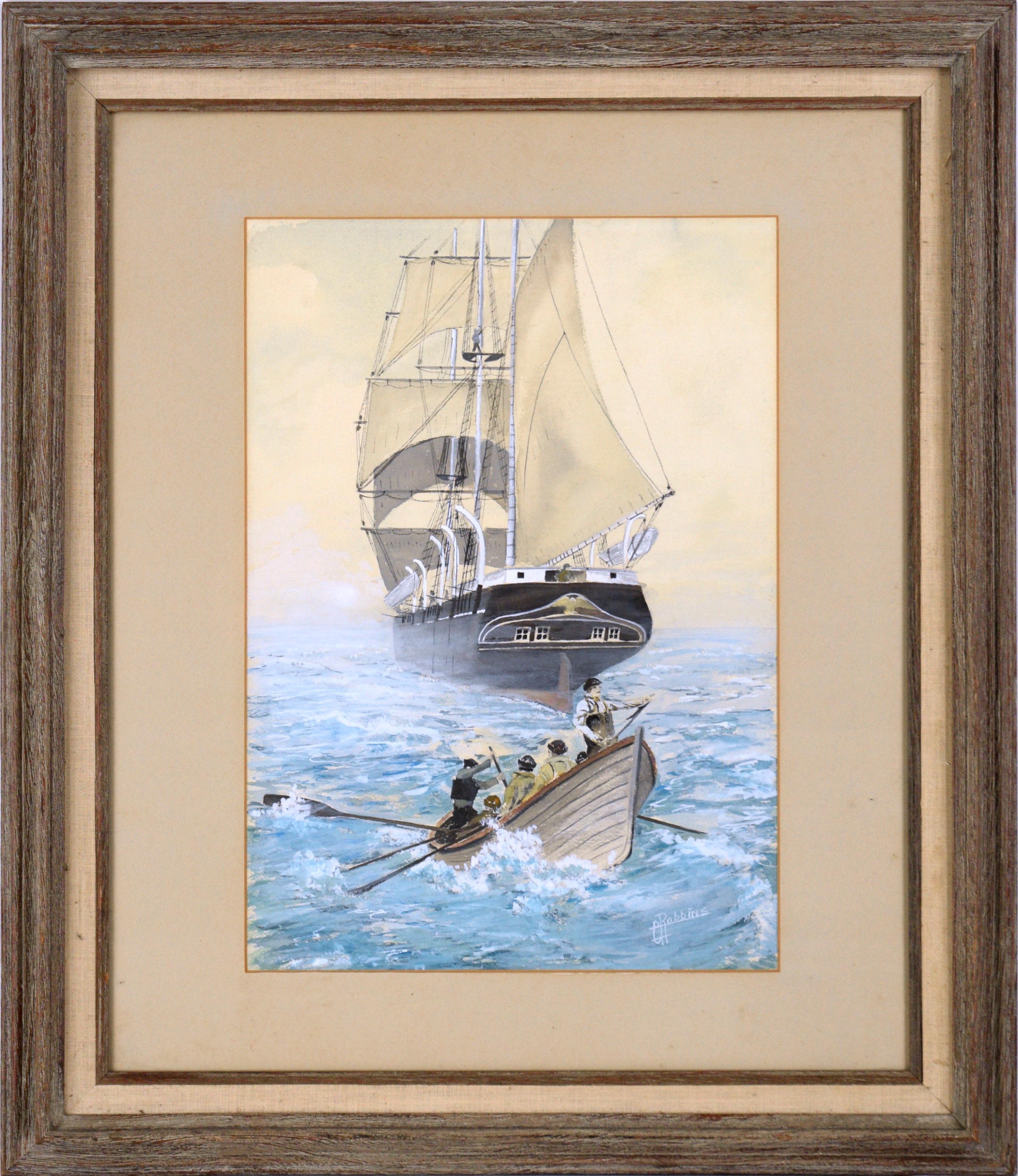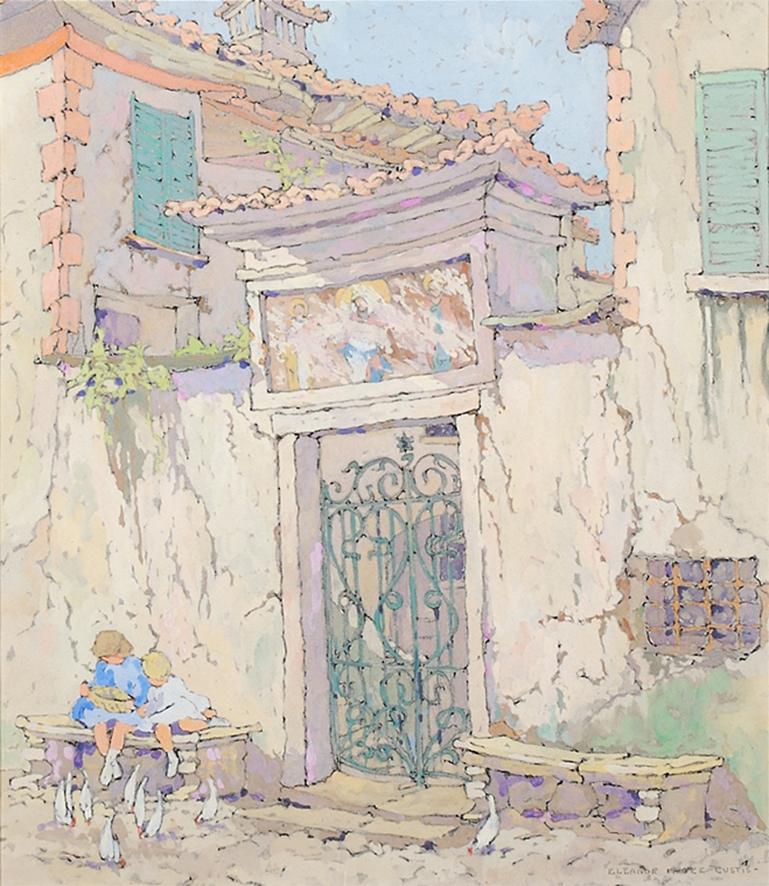Items Similar to Colonel Bates Leads the 30th Colored Infantry at the Battle of the Crater
Want more images or videos?
Request additional images or videos from the seller
1 of 9
Abbott Fuller GravesColonel Bates Leads the 30th Colored Infantry at the Battle of the CraterCirca 1903
Circa 1903
About the Item
Colonel Bates Leads the 30th Colored Infantry at the Battle of the Crater
Watercolor on Paper Circa 1903
15 ½ x 21 ½ Inches 25 ½ x 33 ½ Inches Framed
LR: Graves
This rare portrait of African American troops serving in battle during the Civil War depicts the 30th United States Colored Infantry at the Battle of the Crater, at Petersburg, Virginia. The regiment was composed of African American enlisted men commanded by white officers and was authorized by the Bureau of Colored Troops which was created by the United States War Department on May 22, 1863.
The Battle of the Crater, July 30th, 1864, was part of the Siege of Petersburg, fought between the Confederate Army of Northern Virginia, commanded by General Robert E. Lee and the Union Army of the Potomac, commanded by Maj. Gen. George G. Meade (under the direct supervision of the general-in-chief, Lt. Gen. Ulysses S. Grant).
At the top of the painting, Colonel Delevan Bates raises his saber to lead the charge of the 30th United States Colored Infantry. Bates was promoted to this command just prior to this battle, having served with distinction in the 121st New York Infantry at the Battles of Fredericksburg, Chancellorsville and Gettysburg. Though the Battle of the Crater would eventually be won by the Confederacy, it was here that Bates and 23 other troops would be award the United States highest award for bravery during combat, the Medal of Honor.
After weeks of preparation, on July 30, Union forces exploded a mine in Maj. Gen. Ambrose E. Burnside's IX Corps sector, blowing a gap in the Confederate defenses of Petersburg, Virginia. From this propitious beginning, everything deteriorated rapidly for the Union attackers. Unit after unit charged into and around the crater, where soldiers milled in confusion. Grant considered the assault "the saddest affair I have witnessed in this war." The Confederates quickly recovered and launched several counterattacks led by Brig. Gen. William Mahone. The breach was sealed off, and Union forces were repulsed with severe casualties. Brig. Gen. Edward Ferrero's division of black soldiers were badly mauled. This may have been Grant's best chance to end the Siege of Petersburg. Instead, the soldiers settled in for another eight months of trench warfare. Burnside was relieved of command for the last time for his role in the debacle, and he was never again returned to command.
Bates was seriously wounded in the battle but survived the war, mustering out honorably in December 1865. He eventually moved back to New York, married and had a family, and was a merchant and shopkeeper.
A full account of the battle and a full page illustration of this painting was published in the book, "Deeds of Valor" in 1903.
Though the work is signed, we consider it an attribution to Abbott Fuller Graves, as it is unclear if the work was done by him or another artist of the same surname. However, another battle scene illustration by Abbott Fuller Graves has come up in the past, which appears to be done by the same hand.
Sight Size: 15 ½ x 21 ½ Inches
Signed LR: Graves
Illustrated: Deeds of Valor, The Perrien-Keydel Company, 1903, Vol. 1, page 391.
- Creator:Abbott Fuller Graves (1859-1936, American)
- Creation Year:Circa 1903
- Dimensions:Height: 15.5 in (39.37 cm)Width: 21.5 in (54.61 cm)
- Medium:
- Movement & Style:
- Period:
- Condition:
- Gallery Location:Costa Mesa, CA
- Reference Number:1stDibs: LU2139212467532
Abbott Fuller Graves
Abbott Fuller Graves was an American painter and illustrator who specialized in decorative open air garden paintings and floral still lifes. His use of thick brushstrokes, bright colors, and natural light shows the influence of European impressionism. Graves was born in Weymouth, Massachusetts, on April 15, 1859, the son of James Griswold Graves and Eliza Nicholls (Fuller). Hoping to become an architect, Graves attended the Massachusetts Institute of Technology but did not graduate. Graves went to Paris and Italy in 1884 to refine his skills as a flower painter. In Europe, he roomed with Edmund C. Tarbell. After returning to Boston in 1885, Graves became a teacher at the Cowles Art School, where his friend Childe Hassam was also on the faculty. The two painters undoubtedly influenced one another. In 1887, Graves returned to Paris to study figure painting at the Academie Julien. Graves returned to Boston in 1891, and lived in the coastal town of Kennebunkport, Maine, where he taught painting classes in oil and watercolor. He continued to visit there in later years, painting genre scenes featuring farmers, fishermen, firemen and old sea captains of Kennebunkport. Many of his portrayals of small-town life were reproduced on calendars and postcards. After 1891, the majority of Graves's works depict gardens and floral landscapes, some including female figures. Some portray exotic gardens of Spain and South America. In 1891, he opened his own art school in Boston. The school later moved to Kennebunk, Maine. From 1902 to 1905, Graves was employed as a commercial illustrator for magazines and studied at the Académie Vitti in Paris. After 1922, Graves spent his winters in New York City, where he belonged to such organizations as the National Academy of Design, the National Arts Club, the Salmagundi Club and Allied Artists of America. Examples of Graves’s work can be found in public and private collections across the country, including the Mead Art Museum at Amherst College, the Arnot Art Museum, Elmira, New York; the Brick Store Museum, Kennebunk, Maine; Ball State University Museum of Art, Muncie, Indiana; the Hermitage Foundation Museum, Norfolk, Virginia; and the Princeton University Art Museum, Princeton, New Jersey.
About the Seller
No Reviews Yet
Vetted Seller
These experienced sellers undergo a comprehensive evaluation by our team of in-house experts.
Established in 1972
1stDibs seller since 2022
5 sales on 1stDibs
- ShippingRetrieving quote...Ships From: Costa Mesa, CA
- Return PolicyA return for this item may be initiated within 7 days of delivery.
More From This SellerView All
- Dreaming Anew, Departing New York HarborBy Henry BaconLocated in Costa Mesa, CAPensive in thought sitting at a wood-slat stern bench of a departing vessel in New York Harbor, the prominent grandeur of the Statue of Liberty recently passed, a woman and her loyal...Category
1890s Figurative Paintings
MaterialsOil, Panel
- Pluie a Venice (Venice in the Rain)By André HambourgLocated in Costa Mesa, CAPluie a Venice is painted in Hambourg's preferred palette of muted blue-green, grey, and gold with splashes of ruby red, deep blue, and emerald green. The soft colors work well for beach scenes and rainy days such as the ones portrayed in this painting. The impressionistic scene shows multiple pedestrians strolling down the boardwalk, shielding themselves from the rain with colorful umbrellas that provide pops of color and balance the overcast sky. The background contains a three-masted ship and Piazza San Marco's famous bell tower and Basilica. Hambourg uses the minimum number of brushstrokes necessary to portray ships, seagulls, buildings and people as well as reflections on the glistening sidewalk. The brushstrokes in the sky have an interesting texture that is controlled yet carefree and there is heavy impasto throughout. His portrayal is both realistic and romanticized. Hambourg was clearly influenced by the great Impressionist artists of earlier generations, perhaps none more than the one with a direct connection to his family. Hambourg's wife, Nicole Rachet, was born into a family with a large collection of works by Impressionist master Eugene Boudin. Rachet's grandfather was a contemporary and friend of Boudin's, and a collector of his work. In their later years, Hambourg and Rachet donated over 300 canvases by Boudin and other artists to the Eugene Boudin Museum in Honfleur, France. It was such a large and important gift that the collection bears...Category
1960s Post-Impressionist Landscape Paintings
MaterialsCanvas, Oil
- PrintempsBy Charles LevierLocated in Costa Mesa, CAA beautiful woman sits at an open window, gazing down at a small bird who has landed nearby in this serene portrait by Charles Levier. Warm orange tones are played off their complements in shades of blue, the artist utilizing several different layers of oils to create a subtle and relaxed view of a spring day near the sea. Beyond the window a small chapel sits on a peninsula, surrounded tranquil blue waters. This work, like many of Levier's, belongs to the French figurative movement of the Glorious Thirty (Les Trente Glorieuses) - the golden period of thirty years after WWII which were a time of great hope and prosperity in France. Inspired by Hollywood cinema, Charles Levier sought harmony in composition and purity of color and form. His said that his creations represented "a light and delicate world, of dark and subtle shades and colors." Levier worked in a somewhat abstracted, cubist style. Additionally he often employed the French technique of "cloisonnism" (after the French for "partition"), a style of post-Impressionist painting with bold and flat forms separated by dark contours, also seen in this work. The term was coined by critic Edouard Dujardin on the occasion of the Salon des Indépendants, in March 1888 and was commonly used by artists like Émile Bernard, Louis Anquetin, Paul...Category
Mid-20th Century Post-Impressionist Figurative Paintings
MaterialsCanvas, Oil
- On the Coast of Holland, Fishing Boat Ready for SeaBy William Edward NortonLocated in Costa Mesa, CAAn interesting homage to the issue of rank amongst the crews and officers of all vessels, a captain is carried to his ready command by one of his subordinates through the ocean surf ...Category
1890s Other Art Style Landscape Paintings
MaterialsCanvas, Oil
- Breaking SurfBy Sally SwatlandLocated in Costa Mesa, CABlessed with natural artistic ability and finding encouragement from her family at an early age, Sally Swatland has traveled the proper paths to find herself in a unique place: the foremost American woman painting children at the seashore. With a romanticized nod to yesteryear, Swatland's characters are innocent and fair, in an array of matching springtime and summery apparel. Adept with brush and palette knife, she blends many artistic influences and styles into her own unique presentations. This painting features a fair-haired young girl dipping her feet in the shallow waters along a rocky shoreline. The sea behind is a brilliant blue with small white-capped waves rolling into shore. The brushwork alternates between smooth strokes in the child's form and dress and more impasto work and sharper edges on the rocks and in the more active parts of the sea. The overall effect is that of being at the sea and finding serenity in the contrast between the calm shore and the always moving ocean. The seas' eternal inspiration form a common backdrop to many of Swatland's artistic works. Born in Washington D.C., her family moved to Greenwich, Connecticut and often summered at Tod's Point, Long Island Sound. She would go on to become an art major at Mount Saint Vincent College, study under Robert Schulz in the Art Students League of New York, and come to be represented early by Alistair Stair in his New York and Florida galleries...Category
Early 2000s Contemporary Landscape Paintings
MaterialsOil, Board
- Barkentine THOMAS P. EMIGH with Photos and EphemeraBy William EdgarLocated in Costa Mesa, CAReaching under full sail, including a jib-headed "kicker" topsail on the Jigger mast, the white-hulled barkentine THOMAS P. EMIGH is depicted approaching what appears to be the headl...Category
Early 1900s American Realist Paintings
MaterialsCanvas, Oil
You May Also Like
- Raggedy Ann Dolls by Grace Pischner MillerLocated in Soquel, CAGrace Pischner Miller was born in Washington on January 12, 1912. She painted primarily in watercolors. She specialized in landscapes and seascapes of California. Two paintings of "Raggedy Ann...Category
1960s American Realist Figurative Paintings
MaterialsPaper, Watercolor
- Rowing to Shore - Nautical Seascape in Gouache on PaperLocated in Soquel, CANoble nautical scene of a small rowboat coming to shore from a larger sailing vessel by George A. Robbins (American, 1918-2010). In the foreground, sever...Category
Late 20th Century American Realist Landscape Paintings
MaterialsPaper, Gouache
- The GatewayBy Eleanor Parke CustisLocated in New York, NYSigned (lower right): ELEANOR PARKE CUSTISCategory
20th Century American Realist Landscape Paintings
MaterialsPaper, Gouache
- 1840 rare watercolor, Native American encampment, Western Indian Unknown artistLocated in Buffalo, NYA rare mid 19th Century watercolor depicting Native Americans approaching a fort. The subjects appear to be from a Northern Plains Tribes, and arre approaching a palisades style f...Category
1840s American Realist Landscape Paintings
MaterialsPaper, Gouache, Watercolor
- A Good Book and a Lake. Poverty Point State ParkBy Kathryn KellerLocated in New Orleans, LAPoverty Point Reservoir State Park in NE Louisiana.Category
2010s American Realist Figurative Paintings
MaterialsPaper, Watercolor
- Island Games (Lucky Shot)By Stephen Scott YoungLocated in New York, NYImage dimensions: 29 ¼ x 21 ½ inches Framed dimensions: 45 x 37 inches Signed and dated at lower left: SSYoung / 99' Island Games (Lucky Shot) depicts a pair of young Bahamian boys engaged in a game of marbles, one of the artist's signature themes. Scholar William Gerdts writes: In these works, Scott not only depicts young individuals engaging in a popular activity but shows their intensity and competitiveness while conveying their camaraderie. The pictures are not so much about "winners" and "losers" as about the boys' concentration on the game and the interest shown by onlookers....The sense of community evoked in the series suggests that playing marbles...Category
1990s American Realist Figurative Paintings
MaterialsGouache, Watercolor, Archival Paper
Recently Viewed
View AllMore Ways To Browse
The Charge
After The Battle
Battle And American
Medal Of Honor
African American Family
Battle Scene Paintings
Antique Battle Painting
American Civil War Paintings
African American Antique
Siege Of
Battle Portrait Painting
Antique Grave
Signed Bat
Bat Painting
African Art 1900
American Bureau
Antique African American Art
Antique Bat




